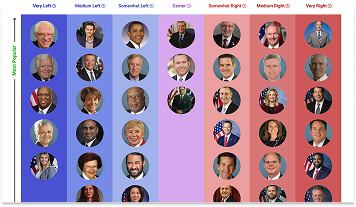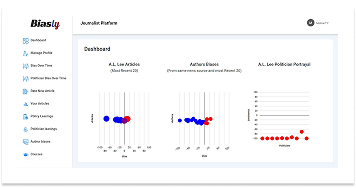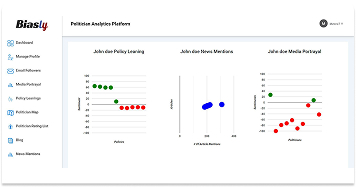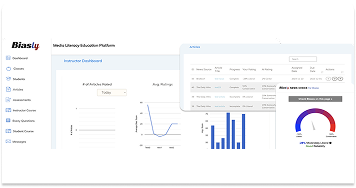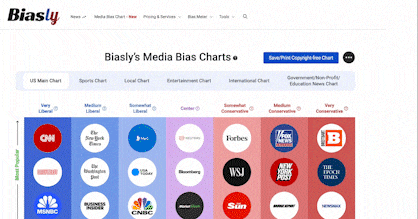Bias Meter
Extremely
Liberal
Very
Liberal
Somewhat Liberal
Center
Somewhat Conservative
Very
Conservative
Extremely
Conservative
-100%
Liberal
100%
Conservative
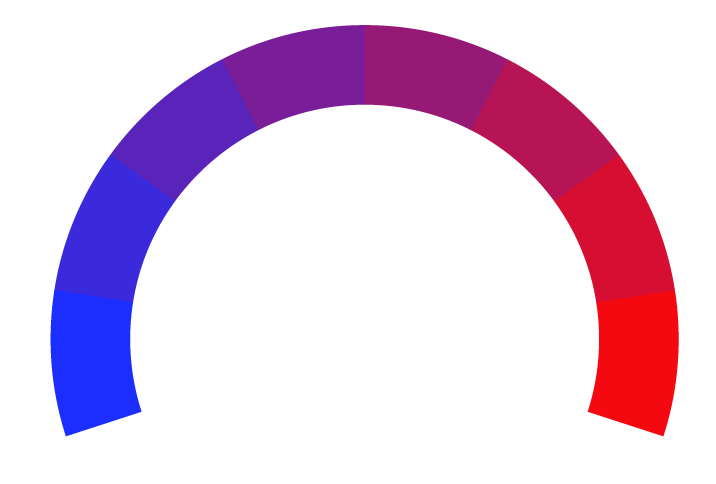
Biasly determines media bias ratings through a dual-layered approach combining artificial intelligence and analyst review. The platform’s proprietary bias detection engine, Bias Meter, evaluates sentiment, policy position alignment, and language framing across thousands of data points in news articles. Analysts then verify and interpret the AI’s findings, providing additional context where needed. Learn more
- Profile
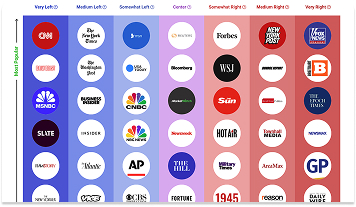
The Salt Lake Tribune on the media bias chart
The Salt Lake Tribune has a Bias Score of -26% Somewhat Left which is based on a variety of factors including its policy and politician leanings, article ratings, and the use of biased language. Its Reliability is rated as Average, and additional analytical insights are available in the other tabs.
- Bias Rating
-26% Somewhat Left
- ReliabilityPolicy Leanings
4% Center
Extremely
LiberalVery
LiberalModerately
LiberalSomewhat Liberal
Center
Somewhat Conservative
Moderately
ConservativeVery
ConservativeExtremely
Conservative-100%
Liberal100%
Conservative
Average Reliability
*Our bias meter rating uses data science including sentiment analysis, machine learning and our proprietary algorithm for determining biases in news articles. Bias scores are on a scale of -100% to 100% with higher negative scores being more liberal and higher positive scores being more conservative and 0% being neutral. The rating is an independent analysis and is not affiliated nor sponsored by the news source or any other organization.
Politician Portrayal36% negative
Continue For Free
Create your free account to see the in-depth bias analytics and more.
By creating an account, you agree to our Terms and Privacy Policy, and subscribe to email updates.
Policy Leanings Analysis
Policy | Bias score |
|---|
Salt Lake Tribune Editorial Patterns
The Salt Lake Tribune’s coverage of political topics often reflects a Somewhat Left bias, with consistent patterns in phrasing, source selection, and thematic focus that leans towards Somewhat Left. While the publication demonstrates journalistic standards in many of its reports, the choice of issues, framing, and word usage can indicate a political slant. This content analysis examines how the Tribune handles liberal and conservative issues and evaluates its language choices and editorial tendencies.
Coverage of Liberal vs. Conservative Topics
The Salt Lake Tribune’s articles include progressive social causes, such as LGBTQ+ rights, racial justice, and climate policy, which tend to adopt sympathetic and supportive language. For instance, its coverage of topics related to abortion rights, clean energy, and anti-discrimination laws frequently aligns with liberal viewpoints, using inclusive and affirmative language to frame these policies as necessary reforms.
On the other hand, articles covering conservative figures or Republican-led initiatives often employ a more critical tone. Biasly’s analysis of recent Tribune articles reveals a tendency to highlight controversies or opposition surrounding Republican policies, while downplaying positive aspects or conservative rationale. For example, in political campaign coverage, Republican candidates may receive more scrutiny, with an emphasis on potential missteps or public backlash.
This news media bias manifests in subtle ways — such as placing greater prominence on Democratic voices, or using emotional diction when describing liberal causes, while offering more detached language in conservative contexts. Words like “justice,” “equality,” and “rights” appear more frequently in liberal-oriented reporting, while conservative views are often framed as “pushbacks,” “restrictions,” or “oppositions.”
Policy and Issue Framing
When covering gender rights, the Tribune often references inclusivity and representation, supporting movements for expanded legal protections. This aligns with a Somewhat Left media bias, especially in Utah, where local culture tends to be more conservative. Similarly, coverage of environmental issues reflects an urgency consistent with climate advocacy narratives — often featuring voices from scientists, community leaders, and activists in favor of green legislation.
In contrast, issues like gun rights, border security, or religious liberties — typically associated with conservative platforms — are covered in a more cautious or critical tone. These stories are often contextualized through the lens of their impact on marginalized groups or framed as polarizing.
Even in neutral coverage, phrasing choices shape perception. Articles will describe liberal proposals as “expanding access” or “strengthening protections,” while conservative legislation may be described as “imposing limits” or “rolling back rights.” This consistent choice of words reflects an editorial direction that, even unintentionally, can contribute to bias in news media.
Coverage and Relevance
The Salt Lake Tribune’s reporting often touches on key issues central to the media political bias discussion — including newspaper bias, bias in journalism, and biased media narratives. As such, it serves as a compelling case study for examining source bias and news media bias in state-focused reporting.
Readers who wish to further explore how The Salt Lake Tribune compares with other publications can visit Biasly’s Media Bias Chart to analyze tone and word choice in real time.
The Salt Lake Tribune Bias Analysis
The Salt Lake Tribune began as “The Tribune & Utah Mining Gazette” in 1871. Today, it functions as an innovative and collaborative news organization, operating as a nonprofit and partnering with 12 other Utah-based outlets to share stories and resources. With two Pulitzer Prizes to its name, the Tribune positions itself as a community asset focused on being an independent voice for the citizens of Utah.
According to its 2024 annual report, The Salt Lake Tribune reached an average of 2.18 million users per month in the previous year. When it comes to media bias, both AI and media analysts have evaluated its content, sources, and funding to determine its political leaning.
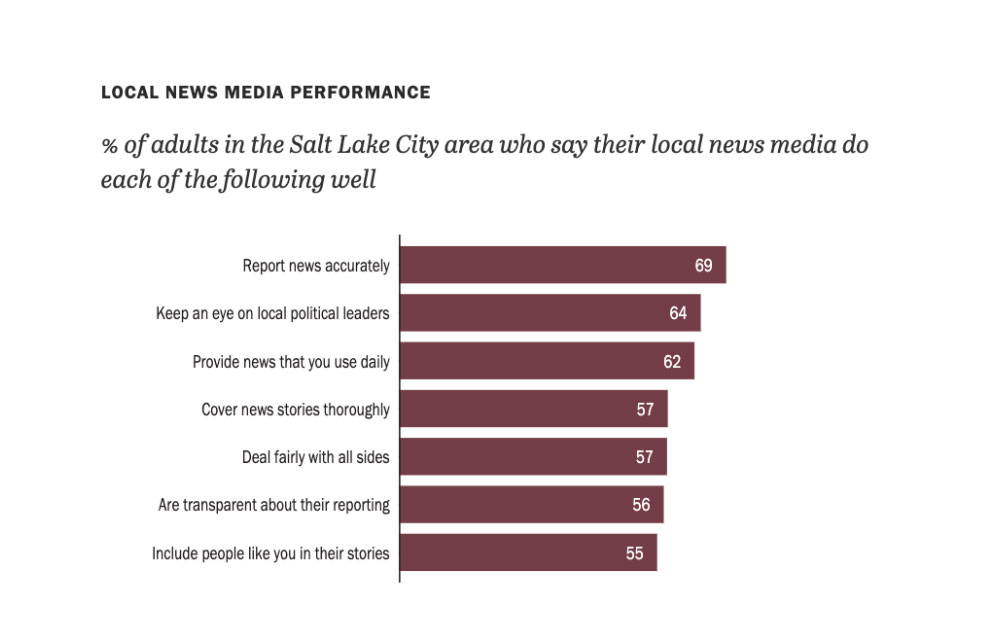
Source: Pew Research
As a leading local media outlet in Utah, the Tribune plays a significant role in shaping public perception. Readers’ trust in the accuracy of local news may mirror the conclusions reached by Biasly’s media bias ratings. This article delves into the Tribune’s editorial tendencies to explore whether political bias is present and, if so, to what degree.
Is The Salt Lake Tribune Biased?
Based on Biasly’s evaluations, The Salt Lake Tribune is rated as Somewhat Left.
By examining content patterns and the broader context of media influence, we aim to offer a balanced perspective on The Salt Lake Tribune’s political bias—and contribute to the ongoing discussion about bias in the news.
How Does Biasly Rate News Sources?
Biasly uses proprietary algorithms and a team of analysts to provide comprehensive bias evaluations across thousands of news outlets. Over 200,000 articles from more than 3,200 sources have been analyzed to identify the most accurate and unbiased stories.
Biasly assigns each outlet three key scores:
- Reliability Score – Reflects factual accuracy
- AI Bias Score – Generated via natural language processing
- Analyst Bias Score – Assessed by human political analysts
These scores are based on seven core metrics: Tone, Tendency, Diction, Author Check, Selection/Omission, Expediency Bias, and Accuracy. These elements help analysts and algorithms evaluate the political attitude conveyed by each article.
Biasly’s Bias Meter ranges from -100% (most left) to +100% (most right), with 0% indicating neutrality. The system evaluates individual articles based on political terms, policies, figures, and sentiment to calculate precise bias ratings.
Is The Salt Lake Tribune Politically Biased?
The Salt Lake Tribune earns Somewhat Left rating for its AI Bias Score. The Analyst Bias Score, Somewhat Left, is generated by reviewers from liberal, moderate, and conservative backgrounds. Analysts reviewed 15 Tribune articles and noted preferences in areas like coverage of liberal politicians and policy topics such as abortion rights and clean energy. However, the paper maintained objectivity on topics like education and national security.
For example, coverage of racial minorities and affirmative action laws reflects a mostly neutral tone, but articles involving Black Lives Matter contributed significantly to the liberal score, with a Somewhat Liberal bias.
A Tribune writer noted in a report:
“We’ve started doing an annual source audit, in which writers count the folks we speak to for our stories and see if they, overall, represent Utah, demographically and economically. And that mentality has been reflected in our staff’s journalism.”
Utah’s demography presents a contrasting backdrop. Pew Research shows that 63% of Utah’s population identifies as Christian, with 50% of them being members of the Church of Jesus Christ of Latter-day Saints (Mormons). Studies show that Mormons are the most strongly affiliated group with the Republican Party.
This means Utah leans more conservative, which could explain differing perceptions of the Tribune’s content. The paper may draw mixed reactions depending on readers’ political orientations.
This Bias score is determined through natural language processing that evaluates the tone, word choice, and opinion embedded in the reporting. Recent AI evaluations highlight liberal-leaning narratives in articles discussing the Republican Party and LGBTQ+ issues.
Analysis of Bias in The Salt Lake Tribune Online Articles
The Salt Lake Tribune has found that in-depth coverage of the Church of Jesus Christ of Latter-day Saints is one of the most effective ways to drive subscriptions. Given that much of its readership is Utah-based—where regional issues take precedence—it’s essential to ask: is The Salt Lake Tribune truly biased?
To evaluate this, we can analyze select Tribune articles through several of Biasly’s bias rating criteria: Tone, Tendency, Author, Diction, and Expediency Bias.
- Tone: The overall attitude conveyed by the article
- Diction: Specific word choices made by the writer
- Author: The background and social presence of the journalist
- Tendency: Patterns of bias in the writer’s broader body of work
- Expediency Bias: Quick visual or textual indicators like headlines and photos that imply bias
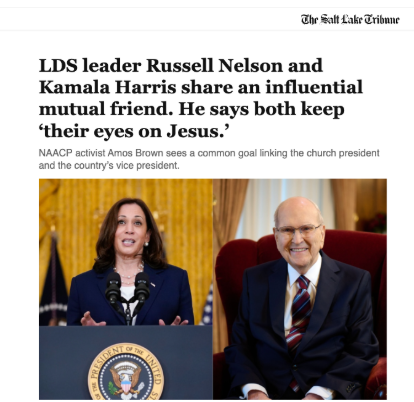
Source: The Salt Lake Tribune
One such article features a headline that draws a correlation between religious leader Russell Nelson and Vice President Kamala Harris. Two photos are placed side by side, supported by a third-party source noting their shared values. The article begins positively, emphasizing their mutual dedication to helping marginalized communities—a message likely to resonate with both Mormon and liberal audiences.
Reporter Tamarra Kemsley outlines their respective work in social justice. For instance, Russell Nelson’s collaboration with Reverend Amos Brown of the NAACP is highlighted. Brown, a civil rights leader and an early confidant of Harris, is quoted extensively. While this lends weight to the article, it also reveals Brown’s personal admiration for both figures, raising questions about objectivity.
“The way Brown sees it, both Nelson and Harris are “followers of Jesus of Nazareth,” who, he told The Salt Lake Tribune on Monday, in their own ways and spheres of influence, are helping to improve life for the downtrodden. In doing so, he said, they are busy enacting the “beloved society” described by one of his personal mentors, Martin Luther King Jr.”
The article leans progressive in its portrayal of Harris and Nelson as advocates for the marginalized, reflecting social justice values. By linking Brown’s admiration to Martin Luther King Jr.’s vision of a “beloved society,” the author aligns the narrative with left-leaning ideals, emphasizing moral leadership and advocacy. This framing, while uplifting, subtly situates the subjects within a progressive ideological lens, further underscoring the article’s ideological slant.
Another Tribune article focuses on Brown’s partnership with the Mormon Church to redress historical racial injustices. Initiatives involving reparations, land access, healthcare, and education—typically championed by liberal platforms—feature prominently.
The article’s portrayal may suggest a Democratic–LDS Church alliance, but the evidence is mostly circumstantial. Some reader comments express skepticism:
“Really Trib, you had to work this hard to find some connection between the presidential race and Mormons…I hope Brown’s endorsement makes it easier for fellow members to support and vote for Kamala.”
The presence of opinion, lack of alternative perspectives, and social media advocacy by the author suggest a slight lean, though Kemsley generally maintains journalistic boundaries in her religion-focused coverage.
On the other hand, another article titled “Civil rights advocate challenges GOP lawmaker in race for Utah’s House District 26 seat” is far more balanced. It lays out the candidates’ positions without editorializing. Phrases and diction like “policy platform,” “legislative record,” and “constituent concerns” reinforce neutrality. Hot-button issues like abortion are presented factually, without spin:
“Would you support a state constitutional amendment to ban abortion?”
“MacPherson: Yes.”
“Williams: No.”
The article employs diction and language that is notably restrained and formal, contributing to its overall neutral tone. Terms like “challenges” and “advocate” are informative but measured, conveying the dynamics of the race without implying aggression or favoritism. The author also avoids emotionally charged words or loaded phrases often seen in more partisan outlets. Instead of framing the contest as a “battle” or “clash,” she refers to it as a “race” or “campaign,” maintaining an even-handed tone.
The reporter, Shannon Sollit, avoids emotional or judgmental language, letting the facts speak for themselves. While her social media presence leans slightly liberal, her writing remains professional and neutral in tone. Here is an example of left-leaning sway used on Shannon Sollit Twitter profile:
Sam Conder expected the huge, standalone steel structures he and his family built to hold trail signs and land markers on BLM land across Utah. He also expected to be paid for the work.
Trump’s IRA funding freeze now means he won’t be. https://t.co/Lb3XCoiaud
— Shannon Sollitt (@ShannonSollitt) February 26, 2025
To sum it up, The Salt Lake Tribune shows inconsistent bias across its reporting. While Sollit’s House District 26 coverage maintains neutrality through balanced presentation and restrained language, the Nelson-Harris article reveals a progressive slant by framing both figures within a social justice narrative that aligns with left-leaning values. The reliance on a source with personal connections to both subjects further compromises objectivity. Despite attempts at balance in some reporting, the Tribune’s tendency to highlight progressive initiatives and frame stories through a social justice lens indicates an overall left-leaning orientation, particularly when covering the intersection of religious institutions and politics.
Analysis of The Salt Lake Tribune Opinion Articles
To fully understand political bias in media, it’s important to distinguish between factual reporting and opinion pieces. While reporting aims to present facts and let readers form their own conclusions, opinion articles express personal viewpoints on current issues. Although the previous section examined factual reporting, this section turns to how bias surfaces through The Salt Lake Tribune’s selection and tone of opinion content.
One prominent example is the op-ed titled “We Must Stand Together for Immigrants, for Education, and for Justice.” The title itself signals a persuasive tone and a clear alignment with progressive values. It implies dissatisfaction with the political status quo—particularly under the Trump administration—and calls for collective action, suggesting that the author prioritizes persuasion over balanced information delivery.
In contrast, another opinion piece titled “Lessons from WWII to Avoid WWIII” employs more centrist language. Its title does not lean toward any political side and frames the issue around a shared desire to maintain peace. The subheading is neutral and avoids emotionally loaded phrasing, indicating that the piece may be less ideologically charged.
These examples show that while not all Tribune opinion pieces are overtly liberal, the platform frequently publishes content that aligns with liberal media narratives. This consistent selection of opinion pieces can contribute to perceptions of systemic bias—particularly when the editorials predominantly support liberal views or causes.
This tendency underscores the importance of distinguishing subjective viewpoints from straight reporting, especially when interpreting the political leanings of any news organization.
Who Owns The Salt Lake Tribune?

Source: The Salt Lake Tribune
The Salt Lake Tribune operates under a nonprofit business model, overseen by a board of 11 volunteer directors. Influential figures such as former Utah State Representative Rebecca Chavez-Houck, Maven District founder Tessa Arneson, and former Natural History Museum Director Sarah George all serve on the board. As of 2024, Tom Love is the current chair, succeeding Paul Huntsman.
Paul Huntsman played a pivotal role in the Tribune’s transition to nonprofit status after removing it from hedge fund ownership. This transformation helped the paper earn its second Pulitzer Prize in 2017, signaling a renewed editorial independence.
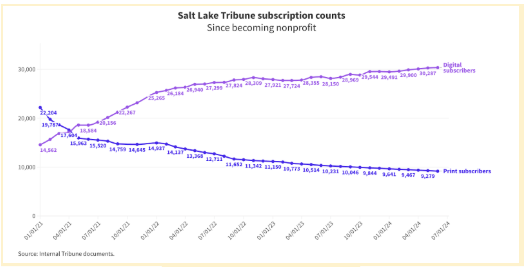
Source: The Salt Lake Tribune
Under its nonprofit structure, the newspaper’s editorial board operates independently of its newsroom and is no longer permitted to endorse political candidates. Moreover, The Tribune’s gift policy asserts:
“No. While we will seek financial support for reporting and special projects, no donor or gift directs or influences the organization’s reporting on issues, people or organizations.”
This reinforces the paper’s public commitment to transparency in journalism, helping ensure that financial contributions do not bias editorial content. While some biases may still arise due to staff perspectives or editorial practices, they are not easily attributed to external funding.
This nonprofit approach may provide added reassurance to readers seeking a news outlet that values independence and editorial integrity.
Who Funds The Salt Lake Tribune?
The Salt Lake Tribune is owned and operated by The Salt Lake Tribune, Inc., a 501(c)(3) nonprofit organization governed by a local board of directors. The outlet converted from a for-profit company to nonprofit status in 2019 after receiving IRS approval, allowing it to accept tax-deductible donations alongside subscriptions and advertising revenue.
Today, it solicits reader contributions and philanthropic support through its membership portal and publishes legal/financial documents on its site for transparency. Its funding now comes primarily from reader memberships, philanthropic foundations, corporate sponsorships, and advertising sales. Reporting on The Salt Lake Tribune’s transition notes a donor-supported model and efforts to build long-term sustainability (including endowment fundraising via the Utah Journalism Foundation), which can diversify revenue but also raises the general risk, common to nonprofit media, of donor influence on coverage if guardrails are weak.
In practice, The Salt Lake Tribune states governance and disclosure measures (e.g., posting IRS 1023/501(c)(3) documents) intended to mitigate such risks; nevertheless, as with any outlet, funding sources and board priorities can shape newsroom incentives over time and should be monitored by readers.
How to Evaluate Bias
Although Biasly rates The Salt Lake Tribune as Somewhat Left, it’s important to remember that bias can vary from article to article. The Tribune also covers a liberal-leaning state with objectivity on many issues, from state legislation to social developments. This complexity underscores the importance of examining each article individually. So, let’s learn how to evaluate media bias.
Recognizing media bias requires awareness and critical thinking. Often, readers trust news sources that affirm their existing beliefs—a psychological tendency known as confirmation bias. This makes it harder to identify slanted narratives or one-sided reporting.
To combat this, it’s essential to challenge your assumptions by consulting multiple viewpoints and verifying news through third-party analysis. Tools like Biasly’s media bias ratings allow readers to compare the same news story across the political spectrum.
Ultimately, bias isn’t always a matter of what is said—it’s also about what is left out, how topics are framed, and which stories are chosen for coverage. Learning to recognize these patterns can help readers make more informed decisions and develop greater media literacy.
To start comparing news outlets and gain a better understanding of bias, sign up for Biasly’s Media Bias & News Analytics Platform to see how stories vary between sources.
The Salt Lake Tribune Reliability Analysis
Is The Salt Lake Tribune Reliable?
The Salt Lake Tribune finds itself toward the middle of the spectrum, with neither high nor low accuracy. Its status as a local news outlet contributes to its moderate reputation for reliability. According to Pew Research, Americans generally hold less politically polarized views toward local news compared to national media. In fact, 85% of adults regard local journalism as at least somewhat important to their community. However, another Pew study reports that satisfaction with local political news coverage remains disproportionately low relative to its airtime.
This suggests that The Salt Lake Tribune’s popularity among Utah residents may not stem from the reliability of its political news coverage. Further investigation is needed to determine whether bias or other factors are affecting its accuracy. At Biasly, we specialize in evaluating not just bias but also the reliability of media outlets. Let’s explore the accuracy and trustworthiness of The Salt Lake Tribune.
How to Evaluate Reliability?
Reliability refers to how trustworthy or accurate a news source is. If we can’t trust what we read, then continuing to consume content from that outlet serves little purpose. So how do we evaluate a news outlet’s reliability?
There are several potential measures of reliability to look out for when trying to determine whether a media source is reliable or not. Red flags for an unreliable article can include the presence of wild unsubstantiated claims, facts dependent on other unreliable sources, heavy use of opinionated language, and more. In contrast, hallmarks of a reliable source include:
- Absence of subjective language
- Citing credible sources (e.g., .gov, .edu, academic references)
- Verifiable facts and statistics from multiple outlets
- Use of primary sources, like interviews or transcripts
- Consistency with coverage across other platforms
Biasly’s reliability scores incorporate these elements in evaluating media outlets.
So How Does The Salt Lake Tribune Fare in Its Reliability?
The political reliability index developed by Biasly assesses both accuracy and trustworthiness. The Salt Lake Tribune currently holds Average Reliability Score, which is calculated as a weighted average of:
- Fact Analysis Score – Evaluates the accuracy of claims, facts, and evidence.
- Source Analysis Score – Assesses the number, diversity, and credibility of sources and quotes used.
The Tribune’s Source Analysis Score is rated as Average at 48%. This suggests moderate trustworthiness in its sourcing practices. The score is AI-generated and considers quote length, frequency, diversity, and quality.
The Fact Analysis Score is yet to be finalized. This score will further determine how well the Tribune supports its claims, addresses selection and omission bias, and presents verifiable evidence. Until this is available, readers are encouraged to perform their own evaluations using Biasly’s media bias tools.
While The Tribune leans toward factual reporting, occasional lapses—such as unbalanced viewpoints or incomplete data—can affect its reliability rating. These nuances emphasize the importance of analyzing individual articles.
The Salt Lake Tribune’s Accuracy and Reliability
According to Biasly’s analysis, The Salt Lake Tribune maintains 48%, but individual articles may vary significantly. Let’s dive into the details.
Political orientation plays a crucial role in how audiences perceive reliability. The Salt Lake Tribune has been accused of favoring a liberal narrative, potentially at the expense of factual reporting. To validate such claims, it’s essential to analyze whether the publication backs its assertions with sufficient evidence and diverse viewpoints.
Two common types of bias that affect factuality include:
- Selection Bias – Highlighting or omitting stories to fit a particular narrative.
- Omission Bias – Leaving out differing perspectives or relevant details to skew perception.
Biasly’s accuracy ratings use a scale from 1% (least accurate) to 100% (most accurate). Factors include the presence of supporting evidence, internal and external reliable sources, and balanced viewpoints.
For instance, Biasly gave the BizPac Review a Somewhat Conservative Bias and an Average Analyst Reliability Score. One BizPac article, titled “Chris Cillizza says corporate media was ‘too willing’ to buy Biden team’s line that he was fit as a fiddle”, showed an Average reliability rating for failing to include diverse viewpoints and for employing inflammatory language. Critical language towards Joe Biden did not stop at the headline either, and reporter Jason Cohen failed to complement his selection of conservative opinions with views belonging to any other school of thought. In contrast, another piece from the outlet, titled “SCOTUS will hear case that could result in country’s first taxpayer-funded religious charter school” featuring legal and political sources with balanced quotes, was rated as Center and scored high for accuracy. The most significant language opposing liberal views here belongs to a politician, whose position naturally required involvement with local education systems. Vivex Saxena reported:
“The plan is supported by Oklahoma State Superintendent Ryan Walters: The problem is that charter schools are considered public schools by default.”
This quotation is characteristic of Saxena’s writing throughout the article, as her unique variation of sources and more extensive quotes produced Good and Excellent reliability ratings on Biasly.
We will take a closer look at more examples like this below to provide a further investigation into the reliability of The Salt Lake Tribune’s articles. This will include its use of selection bias, omission bias, and the quality of its sources and the facts it uses.
Analysis of Reliability in The Salt Lake Tribune’s Online News Articles
The Tribune aims to serve Utahans with objective, fact-based reporting. Its staff includes writers from varying ideological backgrounds, which can help balance coverage. However, readers should distinguish between news reporting and opinion pieces to evaluate credibility effectively.
One notable example is the article titled “Mike Lee says he wants to stop noncitizens immigrants from voting – but has no evidence they are.” Reporter Bryan Schott covered Senator Mike Lee’s claims while referencing past debates and legal records. The article refrains from editorial commentary, sticking to quotes and fact-based language. Despite The Tribune’s Somewhat Left rating, this piece illustrates factual neutrality.
Quality of Sources and Facts Used
The Tribune often uses credible sources from across the political spectrum. However, some articles skew in how comprehensively they present opposing viewpoints.
Consider the headline: “Utah transgender bill threatens millions in federal funds for sexual assault, domestic violence services.” While well-documented and supported by nonprofit data and legal references, the article lacks insight into why the majority of Republican Senators supported the bill. This absence creates a perception that the bill is baseless, despite its passage.
But can readers find evidence opposing the claim made in this article? Emily Anderson, The Tribune’s reporter, mentioned Republican Senator Todd Weiler and his reasons for voting against the bill.
“Among the list of reasons he said he did not support it was the threat the bill poses to federal funding for victim services.”
“That segregation of trans people from spaces aligning with their gender identity goes beyond restrooms and locker rooms.”
Concerning the remainder of Republican Senators who voted in favor of the bill, there is no mention of the data or reasoning behind their support. This lack of information gives readers the impression that the bill in question had no grounds for being passed, despite gaining a majority vote.
In contrast, the article “These Republicans want Mitt Romney’s U.S. Senate seat. Here’s where they stand on Utah’s biggest issues” maintains objectivity. It features multiple Republican Senate candidates and their platforms, without any editorial slant. Where the politicians mentioned might not be favored by readers representing The Tribs’ “Somewhat Left” leaning, the author refrains from making any personal assessments. This allows readers to interpret the differences in thought on their own.
The article gains credibility through its 44 quotes from political candidates—40 long and 4 medium-length. These extensive quotations strengthen reliability by providing full context and minimizing misrepresentation, offering readers a more authentic and trustworthy account from primary sources.
The article features over seven sources, primarily Republican Senate candidates and a campaign spokesperson, along with polling data from different news outlets. While the ideological range is limited to the GOP, it includes some internal diversity, as is seen in the contrast between John Curtis’s more moderate views and Trent Staggs’ hardline stance on issues, along with Brad Wilson.
- John Curtis, U.S. Republican Representative and Senate candidate
- Trent Staggs, Republican Mayor of Riverton and Senate candidate
- Brad Wilson, former Republican Utah House Speaker and Senate candidate
- Jason Walton, Senate Republican candidate and political newcomer
- Carolyn Phippen, Senate Republican candidate and former Mike Lee staffer
- Jordan Hess, Republican campaign spokesperson for John Curtis
- Polling data from Deseret News and the Hinckley Institute of Politics
The article accurately reflects legislative records and polling results. Controversial statements—such as Brad Wilson’s claim about “illegal aliens” voting—are presented as-is, leaving room for reader interpretation.
The article primarily relies on primary sources, which are highly valid and enhance its reliability. Given its focus on the stances of political candidates vying for Utah’s Republican Senate seat, including left-leaning perspectives might typically improve reliability. However, this may not apply here, as the article’s purpose is specifically to highlight Republican viewpoints on various issues.
Selection and Omission Bias
The Tribune provides extensive coverage of Utah’s Republican leaders—which is reasonable given the state’s political makeup. However, bias may still emerge through framing and story selection.
In “Facing threats from GOP election doubters, would Utah’s L.G. endorse Trump?”, selection bias surfaces through the article’s emphasis on negative aspects of Republican discourse. The article does not explore positive initiatives led by Utah’s GOP, nor does it present contrasting viewpoints. Still, it remains rooted in verifiable quotes.
The article does not highlight any proactive or positive measures taken by GOP leaders in Utah (such as improvements to election security, bipartisan outreach, or public education efforts around voting). Therefore, the article leans slightly left in its framing. The author addresses threats and misinformation as largely a GOP-internal problem, without exploring broader or contrasting perspectives. That said, the reporting does not cross into overt editorializing, and is still grounded in verifiable facts and quotes for the most part.
By comparison, the article about Senator Mike Lee shows stronger balance. Reporter Bryan Schott includes quotes from officials across the political spectrum and references documentation available for public review. A notable example of left-leaning bias comes from a source quote:
“Former Utah County Clerk Josh Daniels, who now leads the nonprofit group Trust Utah Elections, says claims that noncitizens are flocking to America to cast a ballot are nothing more than cynical fearmongering.”
Schott uses an extensive number of sources that display diversity of opinion when brought together. The article integrated conversations that took place on conservative platforms, and included responses by politicians at both the federal and state levels. He also referenced legal documentation that is readily available to the public for cross-examination and further analysis, which stands out as particularly objective fact reporting. Overall, Schott used a well-rounded approach to delivering unbiased news to readers of The Salt Lake Tribune.
In opinion pieces, issues with factuality, sources, selection, and omission are frequently present. The articles we’ve covered so far reflect the Tribune’s somewhat left views, but this is not detrimental to its reliability. Its story selection favors issues that are more likely to concern liberals, making it safe to assume it neglects issues within Utah that concern conservatives. However, the contents of the Tribune’s article maintain accuracy and tend to cite evidence from numerous and varied sources.
So, Is The Salt Lake Tribune Reliable?
Overall, The Salt Lake Tribune can be considered to be moderately reliable news outlet. It demonstrates a consistent goal of journalistic integrity and typically supports claims with sources and quotes. Occasional omissions and framing bias do appear, particularly on culturally sensitive or partisan issues.
As media literacy improves, readers can more easily detect issues with selection bias, omission bias, and factuality. To strengthen your ability to assess reliability across the political spectrum, use the News Bias Checker to compare how multiple outlets report the same story.
This empowers you to consume more accurate, balanced, and dependable news.
Additional Insights
News Source Comparison
When it comes to news source comparison, The Salt Lake Tribune is often evaluated alongside other regional and national outlets that lean left or center-left. Sources like The Guardian, Los Angeles Times, or The Seattle Times often present similar tones and editorial philosophies. While The Tribune maintains a somewhat left media bias, it differs from strongly partisan sources in that it occasionally includes opposing viewpoints and strives for regional coverage balance.
This puts it in contrast with more biased media outlets that present consistently one-sided narratives without factual counterpoints. Readers seeking balanced political coverage may compare The Tribune’s framing of issues with outlets rated as Center or Lean Right on our Media Bias Chart, or explore other regional papers on our Similar Sources page.
Notable Contributors and Authors
The Salt Lake Tribune features a diverse range of reporters and columnists, many of whom are deeply familiar with Utah’s political and social climate. Reporters like Bryan Schott, who frequently covers political controversies and election matters, exemplify the outlet’s strength in local investigative journalism.
Other contributors focus on religion, environment, or civil rights—topics central to Utah communities. While some contributors may be seen as leaning left in tone or topic selection, their work is generally grounded in factual reporting. The presence of recurring bylines helps readers evaluate individual journalists’ bias over time.
Related Tools and Resource Pages
To better understand how The Salt Lake Tribune fits into the broader media landscape, we recommend exploring these helpful resources:
- Media Bias Chart: See where The Tribune ranks among hundreds of media outlets across the political spectrum.
- Political Bias Chart: Visualize political slants of news sources across various policy areas.
- Journalist Bias Analytics Platform: Explore how individual journalists contribute to bias within their publications.
- Politician Bias Analytics Platform: Compare how politicians are framed differently by The Tribune and other outlets.
- Media Literacy Education Platform: Learn how to critically assess media sources, bias techniques, and news reliability.
Frequently Asked Questions
The The Salt Lake Tribune is rated as Somewhat Left based on Biasly’s media bias algorithm, which assesses sentiment, article framing, and policy favorability.
While The Tribune is not widely known for promoting fake news, some articles have shown selection and omission bias, especially in political reporting. Its factual reporting is generally sound.
Biasly uses a combination of AI sentiment analysis and human analyst review to assess tone, fact accuracy, source quality, and media bias indicators. Learn more on our Bias Meter page.
Yes, but with caution. The Tribune typically upholds fact-based journalism, though occasional partisan framing and selective reporting may impact overall news reliability.
Ratings are based on recent news using data science and A.I. technology.
Military Spending
| Date | Sentiment | Associated Article | Snippet |
|---|---|---|---|
| 08/25/2019 | 75% For | Trump Family Detentions Flores Agreement (link) | So, of course, the Trump administration is doing the opposite in a baldfaced |























